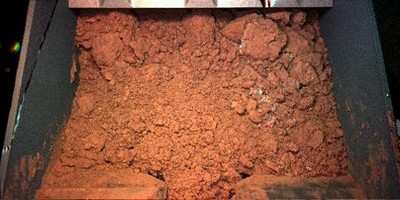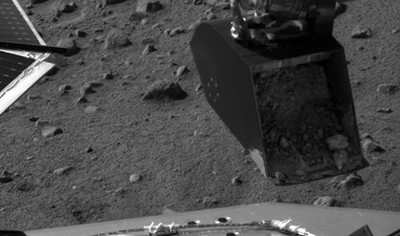Tue, Jun 10, 2008
Just A Little Sprinkle Might Do It
A revised method for delivering soil samples by the Robotic Arm
to laboratory instruments on NASA's Phoenix Mars Lander may yield
some success to failed earlier efforts now that researchers
appreciate how clumpy the soil is at the landing site.

"We're a little surprised at how much this material is clumping
together when we dig into it," said Doug Ming a Phoenix science
team member from NASA's Johnson Space Center, Houston.
As reported Sunday by ANN,
Phoenix’s instruments showed a vibrator on the screen --
designed to help shake soil into the chamber -- was working. But
the electronic sensor to detect dirt falling into the Thermal and
Evolved-Gas Analyzer (TEGA) chamber didn't report any
particles.
The TEGA is designed to bake and sniff samples to identify some
key ingredients central to the focus of the mission to determine if
the northern permafrost region may have the ability to support
life. The analyzer vibrated the screen for 20 minutes on Sunday but
detected only a few particles of the challenging soil getting
through the screen, not enough to fill the tiny oven below.

"We are going to try vibrating it one more time, and if that
doesn't work, it is likely we will use our new, revised delivery
method on another thermal analyzer cell," said William Boynton of
the University of Arizona, lead scientist for the instrument.
The initial method of delivery to get the first sample to TEGA
on Friday required the arm to turn the scoop over and release
it’s contents at once. A revised method requiring the arm to
hold the scoop at an angle above the delivery target and sprinkle
out a small amount of the sample by vibrating the scoop with a
motorized rasp at the bottom was to be attempted Monday.

Sunday, Phoenix used the arm to collect a soil sample for the
spacecraft's Optical Microscope. Monday’s plans included a
practice of the sprinkle technique, using a small amount of soil
from the sample collected Sunday.
If that goes well, the Phoenix team assembled at the University
of Arizona plans to sprinkle material from the same scoopful onto
the microscope later this week.
More News
From 2023 (YouTube Versions): Flying Motorcycle, That Is… "First Flight was achieved under cloudy skies but calm winds. The Samson Sky team, positioned along the runway, wat>[...]
A Few Questions AND Answers To Help You Get MORE Out of ANN! 1) I forgot my password. How do I find it? 1) Easy... click here and give us your e-mail address--we'll send it to you >[...]
Discrete Code As used in the Air Traffic Control Radar Beacon System (ATCRBS), any one of the 4096 selectable Mode 3/A aircraft transponder codes except those ending in zero zero; >[...]
Beyond Visual Line Of Sight (BVLOS) The operation of a UAS beyond the visual capability of the flight crew members (i.e., remote pilot in command [RPIC], the person manipulating th>[...]
Aero Linx: Florida Antique Biplane Association "Biplanes.....outrageous fun since 1903." That quote really defines what the Florida Antique Biplane Association (FABA) is all about.>[...]
 Classic Aero-TV: The Switchblade Flying Car FLIES!
Classic Aero-TV: The Switchblade Flying Car FLIES! ANN FAQ: Q&A 101
ANN FAQ: Q&A 101 ANN's Daily Aero-Term (04.12.24): Discrete Code
ANN's Daily Aero-Term (04.12.24): Discrete Code ANN's Daily Aero-Term (04.13.24): Beyond Visual Line Of Sight (BVLOS)
ANN's Daily Aero-Term (04.13.24): Beyond Visual Line Of Sight (BVLOS) ANN's Daily Aero-Linx (04.13.24)
ANN's Daily Aero-Linx (04.13.24)





